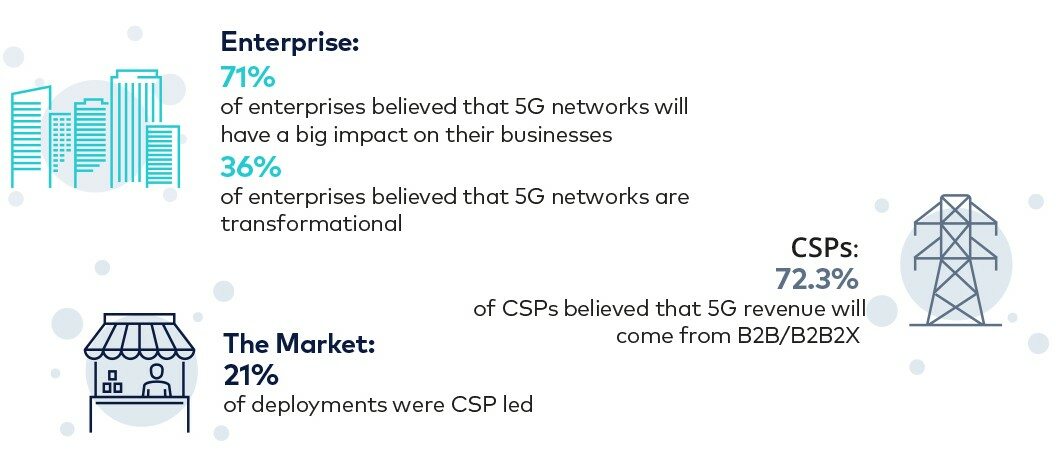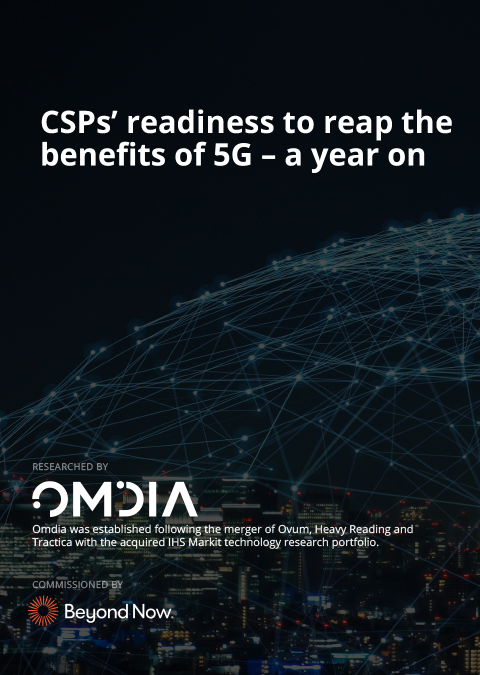
5G is the fifth generation of wireless mobile communication technology that succeeds 4G. Designed to provide faster data speeds, higher bandwidth, lower latency, and improved network reliability compared to previous generations, 5G facilitates faster download and upload speeds, better quality streaming, and improved connectivity.
The potential of 5G is substantial; businesses expect the technology to lead to productivity gains, enable automation, reshape customer experience, and aid product enhancements. With 5G, CSPs can develop new products, services, and business models that can drive revenue growth and improve customer experiences.
Beyond Now recently commissioned in-depth research by Omdia and uncovered some great insights. Enterprises are already relying on 5G technology and have been doing so in a big way since introduced to the market for the first time in April 2019. The research shows that CSPs are realizing the importance of the enterprise 5G market, resulting in an increasing number of CSP-driven 5G enterprise service launches.
The likes of Verizon, Orange Business Services, Telia, Rogers, and many more joined Vodafone, Deutsche Telekom, and Telefónica in announcing private 5G multi-access edge (MEC), campus LTE and 5G networks, and enterprise 5G offerings.
These trends show us that monetizing 5G in the enterprise space may be the biggest opportunity for CSPs. Even though this trend is fairly recent, 36% of enterprises already believe 5G networks will be transformational. The survey also uncovered the following insights:

The majority of enterprises believe that 5G networks will have a big impact, and CSPs should capitalize on that belief to make 5G work for them.
CSPs have an opportunity to satisfy enterprise demand and effectively monetize their 5G services through the provision of tailored, customer-specific solutions that are co-created and jointly delivered by service providers, their suppliers, and ecosystem partners.
However, the main barrier to enterprise 5G adoption is a lack of understanding when it comes to complex services. According to a specialist network vendor, interviewed the Omdia research, “CSPs must own the view that enterprises and partners have of them. They should address their knowledge gap.” CSPs should seek to monetize the 5G offerings in the following ways:
The following trends were also highlighted in the Omdia research, outlining some little-known 5G business opportunities for CSPs in the enterprise space.
While CSP activities have grown in the market, their efforts are sometimes outpaced by smaller players such as private networks specialists, which were already active in the market. There is now an opportunity to leverage this market, by partnering with other players in the market through partner ecosystem management.
Enterprise DIY recently represented 20% of all deals, and while there will always be a number of enterprises that are willing to take full ownership and responsibility for their 5G solution, it is clear that this is not their first priority as most enterprises don’t have the resources or the knowledge to do everything in house and will therefore look for help. This presents a great opportunity for CSPs to step in and fill the knowledge gap.
This model certainly represents a significant opportunity for CSPs, because being involved even as a secondary player means they are still part of the project, and they can drive upsell of enterprise services such as security or integration.
This is the fastest-growing 5G provider model. These providers are often local or specialist players whose main business is delivering private networks to local enterprises and whose strength resides in quickly adapting and shifting resources to target new opportunities. They were fast to identify and react to spectrum developments and opportunities. Overall, its strategy adapts to what the customer wants – it has a deeper vertical understanding and it does not need to balance diverse company priorities like the larger players do. Once again, CSPs can benefit by leveraging partnerships with alternative service providers.
5G presents significant opportunities for both enterprises and CSPs. The potential for 5G to improve productivity, customer experiences, and facilitate product enhancements is substantial. CSPs can offer not only a private network or network slice for B2B2X monetization opportunities, but also the means to help enterprises expand their service offerings. Leveraging partnerships, highlighting differentiators, and addressing knowledge gaps will be important for CSPs to fully benefit from 5G and grow revenue in the enterprise space.

